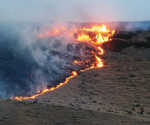400-acre blaze heralds fire season's start

The summer fire season got going last week when an arcing powerline, resulting from high winds that blew through the area June 18, sparked a fire that scorched an estimated 400 acres of grasslands northwest of Glenns Ferry.
Bureau of Land Management fire crews and King Hill Rural Fire District responded to the Moon Fire after Elmore County Dispatch received a report of a fire near milemarker 112 at about 8:30 p.m. last Tuesday.
The Moon Fire burned along the plateau between Cold Springs and Alkali Creek. Traveling southeast and carried by heavy winds, it jumped the King Hill Irrigation District canal and continued toward the interstate.
The BLM dedicated a crew of 15, two engines, one water tender and one dozer to the fire. The King Hill firemen responded with four brush trucks, a water tender and a crew of 12. Two water tankers from the Mountain Home Rangeland Fire Protection Association also responded.
The windstorm caused power outages in Hammett, King Hill and Glenns Ferry.
In Glenns Ferry, 817 Idaho Power Company (IDPC) customers were without electricity from 9:20-11:23 p.m. resulting from a "feeder lockout," said Kevin Winslow, communications specialists with IDPC. At 11:55 p.m., a power outage affected 47 Glenns Ferry customers. Their power was restored at 2:42 a.m. Wednesday morning.
A powerline that serves the Hammett and King Hill areas blew down, causing a power outage that effected 497 customers. The outage lasted from 10:44-11:03 p.m., Winslow said.
Anemometer readings taken at the Suzlon windpark, located west of the fire, clocked sustainable winds at 26.8 mph, with wind gusts up to 31.7, said Tim Cabral, a lead technician with the company.
Local fire officials are urging areas residents to be fire conscious, especially with the Fourth of July weekend approaching. It is illegal to use fireworks that explode or fly into the air. It also is illegal to possess or use fireworks on public lands. Law enforcement officers will strongly enforce that law and will have extra patrols throughout the holiday period. Penalties are a $5,000 fine and/or up to six months in jail. In addition, any person responsible for a fire may be liable for the suppression costs and restitution of the land burned which can involve thousands of dollars.
Despite all the fires in this area last year, there remains a great deal of fuel on the desert and in the mountains, which is rapidly drying out.
No burn bans have been issued yet, but officials are urging anyone conducting a controlled burn to obtain a free burn permit to help cut down on the number of false alarm calls.
Officials with the National Interagency Fire Center in Boise said recently, in its first 2013 summer fire outlook, that a dry winter and predicted warming trend mean the potential for significant fire activity will be above normal in the West Coast states, the Southwest, and portions of Idaho and Montana.
Historically, Elmore County sits at the heart of the area where the most fires in the state are reported.
"We're looking at a combination of a low-moisture winter and a warming and drying pattern in the West that will increase the fire potential,'' said Ed Delgado, manager of the center's predictive services unit.
The area fire danger is forecast to escalate in July and August to above-normal potential.
Due to a low snow pack and lack of spring rain, vegetation conditions are very dry within the Boise National Forest. Some areas normally blocked by snow in late June are open now including Deadwood Reservoir, Bull Trout Campground and many high elevation trails.
"The forest is about six weeks ahead of normal, which means the forest is as dry now as it normally is in early-to-mid August," said Bob Shindelar, Forest Fire Chief.
The prolonged winter dry spell and early snow melt sets the stage for a potentially extreme fire season.
Boise National Forest managers are urging recreationists to be very careful with campfires or any activity that might cause an ignition.
Idaho is coming off one of its worst-ever fire seasons in 2012, with 1,151 wildfires tallied and a nation-leading 1.7 million acres, or 2,600 square miles, burned. Nearly a third of that involved fires in Elmore and eastern Owyhee counties.
